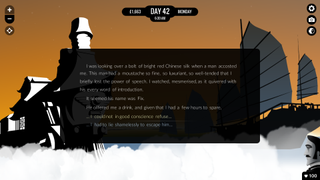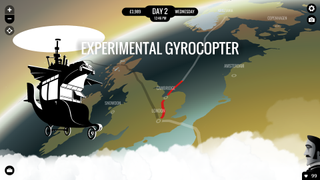Looking back, it's hard to imagine a time when FMV ( full motion video ) felt like The Future.
) felt like The Future. In our defence, it made some sense at the time. 3D was still in its infancy, games desperately sought Hollywood style legitimacy to escape the stigma of simply being toys, and the holy grail of graphics was still photorealism. What better way to achieve it than grabbing a camera, a few actors, and a handy blue wall to shoot them against? Even magazines like, well, PC Gamer got sucked in by the hype, most notably an early issue of the UK edition that gave the front cover to a game called Critical Path, declaring "At last, CD ROM games come of age: the revolution begins on page 80."
In case you're wondering, Critical Path is one of the worst games ever made.(Play it above.)
What went wrong? It's not a difficult question. FMV driven games typically offered the worst of all worlds—not enough storage to hold much footage, not enough budget to make it interesting, and precious little connective tissue between the clips. Critical Path was an example of the 'control room' style, where you were sat away from the action in some way and given lots of things to press—others in that style including early Tia Carrere helmed space puzzle game The Daedalus Encounterand the infamous Night Trap. Others included glorified Choose Your Own Adventure books, usually filled with death to keep you on the right path, such as Plumbers Don't Wear Tiesand shooters like the American Laser Games series. It didn't take too many failures and frustrations for FMV to lose its charm, with the words 'interactive movie' especially going from something proudly emblazoned on boxes to gaming's own Mark of Cain.
"Like all these things, there's probably a lot of choices, and a lot of bad luck," comments Her Storycreator Sam Barlow, whose game has primarily ignited the idea of FMV's return recently. "I mean, the tech at the time was pretty poor—we starting chucking video into games the moment we had the most basic ability to do so—jerky, dithered, postcards of video. In some cases there was as much suspension of disbelief required to see that stuff as video as there was in seeing a CGI world as real. There were the production values—a lot of the people making FMV games were coming from the straight-to-video end of things and the 80s and 90s were cheesy anyway."
And for the most part, all of that is fair. Most FMV heavy games indeed stank. Among them though were some classics, and great examples of the form. Wing Commander 3 for instance looks ropey to modern eyes, but remains a fascinating space epic—not so much for the epic action, but for the subtleties that polygonal characters have only just caught up with. Mark Hamill's leading man, Christopher Blair, stands out particularly here as a man absolutely exhausted by the war and pushing on only because he has no other choice but to be strong in front of the men and women looking up to him.
Elsewhere, Spycraft: The Great Gamedid a pretty good 90s approximation of being a spy and using spy tools, with the addition of actual former heads of the CIA and KGB showing up to add some veracity to what was mostly nonsense. A good main performance could be worth its weight in gold, as seen by the continued love for characters like Gabriel Knight's 2's not-quite-villain von Glower, Chris Jones' increasingly nuanced turn as lovable future PI Tex Murphy, particularly once a real director was brought onboard, and the guy in Return To Zork who asked "Want some rye? 'Course ya do."Truly, gaming's greatest creation since the release of Bouncing Babies.
And I can think of other examples too, mostly from developers that understood that FMV was a stylistic choice rather than a genre—taking advantage of what actors can do, while still integrating the 3D engines and for-then advanced combat systems and puzzles that players expected from other games rather than expecting the video footage to carry everything on a wave of technological superiority.
As with most technologies though, FMV didn't so much disappear as take a step back—typically returning in bursts, for interesting games like In Memoriam(later renamed Missing), a mix of puzzle game and mystery, or for Command and Conquer to embrace its campy roots only with the budget to hire the likes of Tim Curry and George Takei to stomp around and fight for the future. Or interesting experiments, like the comedy YouTube adventure The Dark Room.
Most recently of course, Her Story gave it a massive shot in the arm by showing the world that FMV was still around in new and interesting games, as well as an object lesson in how to use it—not as a template to follow as such, since it is after all very much a control room experience and those never really worked out before, but by focusing on what video can do well and designing around those strengths instead of trying to cheaply compensate for its weaknesses using a green-screen and a few quickly rendered effects.
There's something about interacting with the 'reality' of video that is more intimate, disarming.
"I guess my starting point was that there's something ordinary or everyday about video footage—I was reacting to the prevalence of YouTube, of cell-phone footage leading the ten o'clock news, of reality TV shows, etc," Barlow explains. "There's something about interacting with the 'reality' of video that is more intimate, disarming. It's everyday, whereas so much of video games is fantastical and special. There's no barrier to empathizing with the fictional character on screen, the player is free to read the performance as if it's just another human sat across from them. For Her Story it was important you feel something when looking at Viva's performance, that there's a part of you that buys into this being real."
We may be in an era where we can put any celebrity into any major game, but we're notably not past the point where that stands out—Kevin Spacey in House of Cards is a very different proposition to Kevin Spacey in Call of Duty. "There's still a part of us that when we see a CGI character, we try to see the strings behind it, we look for the flaws. So your brain is hung up on the 1% of CGI Kevin Spacey that isn't Kevin Spacey. You second guess whether deliberate parts of the performance were just that."
The new niche
While the 'triple-A' industry has no interest in FMV games, it's notable how often it still borrows from what video can do well—live-action trailers for instance, like this Arkham Knight one. There's a definite resonance to the acting, simple as it is, that you don't get from the equivalent polygons. The look in an eye. The nervous twitch. The rain splashing in a dark alley without killing the bloody frame-rate, Warner . When the game footage clicks in, suddenly we're in a very different world that looks so much more plasticky and unreal. Over in console land, the new Guitar Heroalso uses FMV for the same of verisimilitude—computers can create anything, but they can't get the raw resonance of a screaming crowd.
Indie developers though are increasingly looking to video—not as a huge wave, but more often than you might think. In addition to Her Story for instance, we've recently seen the online mystery Cloud Chamber, fighting game Stay Dead Evolution, a return of the classic Sherlock Holmes Consulting Detectiveseries, the driving game/B-Movie mash-up Roundabout, and most recently, the adventure games Contradictionand Missing. That's just on PC—the iPad has plenty of other examples. And really, it makes sense. Originally, the sheer cost of FMV anything made for high budgets and big risks. In this YouTube era, where at least prosumer grade cameras are cheap and tools are easily available, it's a niche that can get great results.
Here's a way to have a 'photo-realistic' performance with 'amazing skin shaders' without spending millions.
"I can shoot a week's worth of footage on location without needing a huge crew, without having to go to a big studio and hire out very expensive cameras and capture equipment. This is something that most people aren't thinking about from an indie perspective—hey, here's a way to have a 'photo-realistic' performance with 'amazing skin shaders' without spending millions," explains Barlow, adding "the cost and complexity of CGI means it's now starting to make sense to use video instead—if the genre allows it. So Guitar Hero or Need for Speed—where you don't need that seamless link between 'in game' and 'movie', the big publishers are shooting video instead. Because it's just easier to get some actors and dress them up and shoot that, rather than do it via high end performance capture."
This isn't to say that it's easy though. Unlike Her Story, with its simple set, Tim Follin's Contradictionopted for a real-world shoot, with all the difficulties that entails. "I had to ditch most of the physical puzzle side of the game because we simply didn’t have anything like the time or resources to film what we needed. Most of the location scenes in the game were shot very quickly—for instance we only had a single morning in the pub and had to make a swift departure when a funeral party started arriving for lunch!" He also warns that using FMV over computer graphics isn't an automatic win on the production side. "(Players) are far less forgiving, and seem to approach the game automatically as if they're watching a TV drama."
One advantage both developers have had is that we're so far away from the bad old days that the stigma of FMV has largely faded—or at least, become an opportunity. "It's probably been a help, in that people will write 'Hey, it's an FMV game that doesn't suck!'" jokes Barlow. "I wonder how many people who are buying Her Story have actually seen an FMV game in the wild? Kids who are streaming video on their iPhone and watching all sorts of embedded video in their favorite websites might not even realize this is a thing that happened before."
Follins concurs. "I'm sure it's either just coincidence or something in the zeitgeist that has led to this block of FMV games released recently. Though in my defence, I started working on this around 3 years ago and released the iPad version in January, so I had no idea all these games would come out now!"
A lot of that early FMV stuff had the sense that just putting some actors on screen was enough...
The biggest advantage that both their and other games have is that the definition of 'game' is now far wider than it used to be—cheaper prices and wider reach allowing for more experimental work to find a home that it couldn't when every FMV game had to be a big box of up to 8 CDs on store shelves. It also helps that FMV in itself no longer has its original 'wow' factor—that both it and the technology it requires are now ready to be one tool among many, rather than being a round peg in a square hole or everything having to do double-duty as the future of the industry. At that, it has obvious uses, for the same reasons and purposes that people still make TV and movies instead of rendering absolutely everything on a computer.
"The writing in games, the narrative thinking is so much better now, it means that games people can bring their ideas to the video space, rather than the other way round. A lot of that early FMV stuff had the sense that just putting some actors on screen was enough..." says Barlow. "Now we're in a position to actually have some idea what we want to do with them once we've got them there."

















